The Galactic Republic (25,053 BBY–19 BBY) was the ruling government of the galaxy that existed for more than twenty-five thousand years, until its reformation into the Galactic Empire in 19 BBY. Throughout its existence, the state was commonly known as the Republic. In the post-Republic era and beyond, it was remembered as the Old Republic; it was also rarely known as the Old Galactic Republic or the First Galactic Republic. At times, the term Old Order was used to describe the Republic but was not common.
The Galactic Republic was a representative democracy, composed of various star systems, sectors and member worlds throughout most of the known galaxy. Its central government consisted of three branches: legislative, executive and judicial. The first was the Galactic Senate, a body of elected or appointed representatives. Its main duties included mediating disputes over issues ranging from planetary to galactic-scale, regulating trade routes between star systems, and in theory, represented the interests of Republic citizens. The Office of the Supreme Chancellor was the Senate's executive counterpart. The Supreme Chancellor was elected from the ranks of the Senate by its members. As the leader of the Senate and the overall representative of the Republic, the Chancellor also held the titles Head of State and President. The judicial branch consisted of the Supreme Court and the lower . The Supreme Court was composed of twelve justices, one of whom held the leadership position of Chief Justice.
Throughout most of its history as the dominant galactic power, the Republic did not style itself as a strong centralized government, but rather as a union of sovereign planets for the purposes of collective security and economic prosperity. It was said that its complete history could "fill a thousand libraries." In the last decades that preceded the rise of Emperor Palpatine's New Order, the Republic was a benevolent—though ineffectual—government tied up in layers of bureaucracy, hampered by political and corporate corruption. The Galactic Republic, which had existed for at least 25,034 years, was brought down by the Sith when they transformed it into the Galactic Empire. This, however, was just the first of seven regime changes that replaced the Old Republic over the next 157 years.
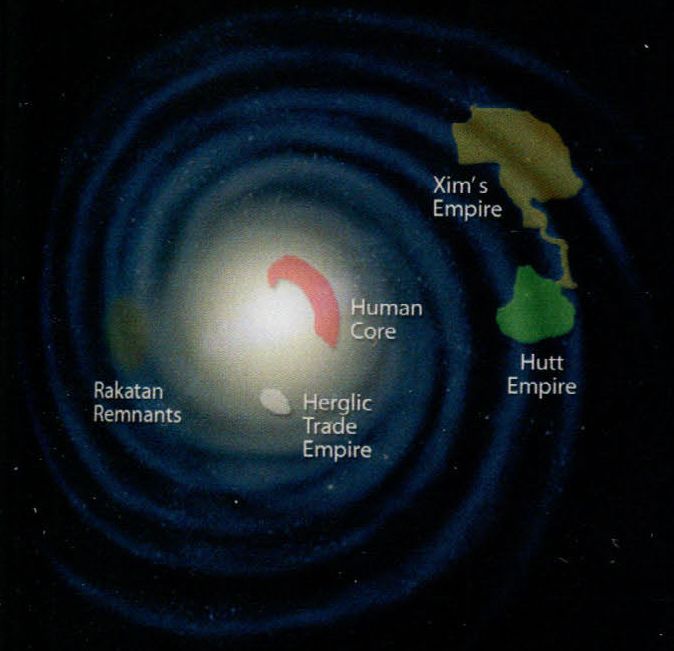
The Human Core around which the Republic was formed
The Republic was born with the ratification of the Galactic Constitution in 25,053 BBY, during the Unification Wars. During that time Humans and Duros reverse-engineered the Force-based technologies of the Infinite Empire to create the first hyperdrive, allowing Coruscant to become the capital of the Galactic Republic 53 years later and would remain that way for twenty-five thousand years. The founding members of the government, largely Humans from the Core Worlds were protected from outside influence by the clandestine group known as the GenoHaradan, an organization which wished to see the government flourish and whose existence was unknown to the galactic populace, even the Jedi Order.
Shortly after the formation of the Republic, the Perlemian Trade Route was mapped, linking Coruscant to Ossus, and bringing the Jedi Knights into the Republic. A key world of this route was Muunilinst which was the source of the Republic credit that traded with the native Muun who controlled the newly formed InterGalactic Banking Clan. Over the next millennia, the Corellian Run was mapped, linking Coruscant to Corellia and beyond. The wedge defined by the two trade routes became known as "the Slice." Since the stretch of hyperspace galactic-west of Coruscant was anomaly-ridden and impassable for the current Republic technology, the government expanded eastward instead. The Core Worlds portion of the Slice was known as the Arrowhead, and soon the Republic expanded into the Colonies.
Though history often recalls the Republic as peaceful, numerous galactic conflicts, such as the Hundred-Year Darkness, the Old Sith Wars, the Vultar Cataclysm, the Mandalorian Wars, the Jedi Civil War, the New Sith Wars, and the Clone Wars, occurred throughout its existence.
The former symbol of the Republic, before being replaced with later symbols.
At first, the government on Coruscant wished for slow expansion, despite its promotion of hyperspace exploration. However, against the government's wishes, the membership of the Republic boomed for its first millennium of existence, mainly due to worlds wishing to join as protection against the Hutt Empire. In 25,000 BBY its capital had officially become a galactic hub, by then the Hutt Empire had fallen and became Hutt Space.
For years, the Jedi Knights and the ancient armies and navies of the Republic defended against violence. Around 24,500 BBY, the First Great Schism occurred, after the Legions of Lettow were established by dissident Jedi who believed that true power was achieved not through passive meditation, as taught by their Jedi Masters, but through emotion. The tension between the Jedi and these dissident Fallen Jedi led first by Xendor, and then after Xendor's death, by Arden Lyn, grew until conflict erupted.
In 24,000 BBY, the Republic entered into the Tionese War against the Honorable Union of Desevro & Tion. The war traveled up and down the Perlemian, and the respective capitals of Coruscant and Desevro both suffered volleys of pressure bombs. The Republic eventually won the war by stirring up the Hutts against the Tionese. Within a century, most of the Tion Cluster swore allegiance to Coruscant, except for Desevro, which chose to remain independent.
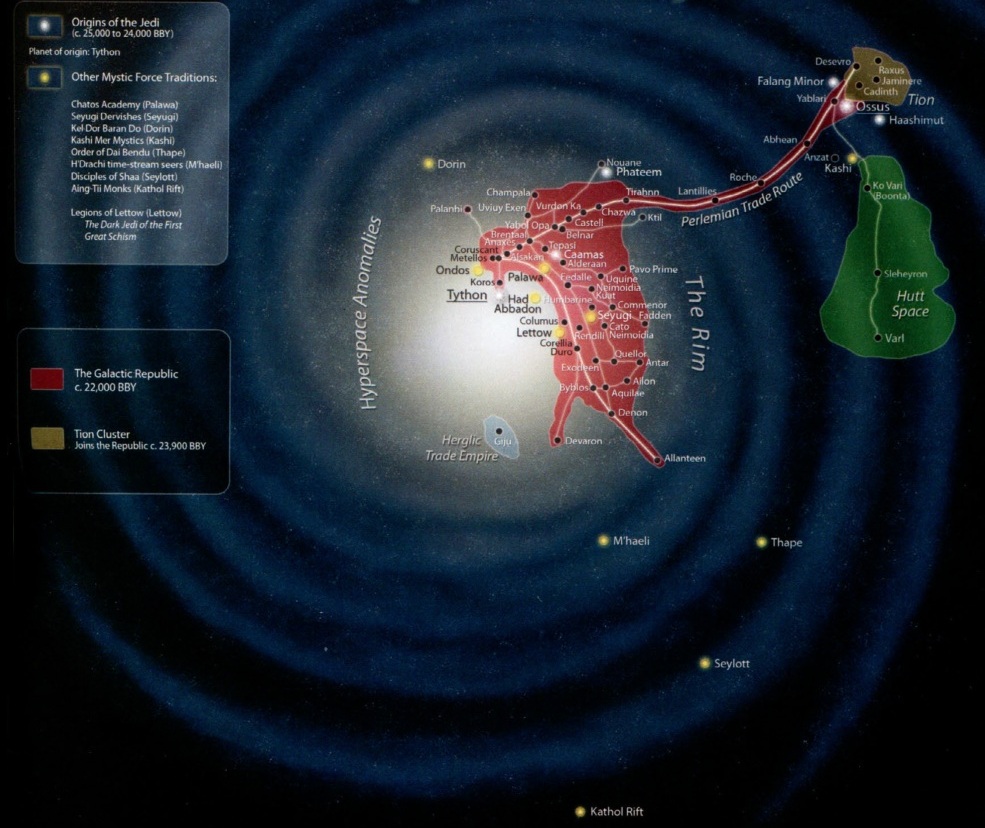
The early Republic around 22,000 BBY.
During the Great Manifest Period (20,000 – 17,000 BBY), the Republic expanded eastwards across the galaxy. Despite this, the Slice would remain the heart of navigable space. Eventually, the Republic expanded past the galactic-northern and -southern borders of the Slice, though most of the galaxy was still unknown, except for outposts such as Ord Mantell (12,000 BBY) and Malastare (8000 BBY). The space west of Coruscant still remained unexplored since analogs to the Perlemian Trade Route and the Corellian Run in that direction still had not been discovered. Worse, progress was limited to dangerous one- or two-light-year jumps into a stretch of hyperspatial anomalies. During this period, the Expansion Region was formed. However, this region suffered greatly as a result of the Alsakan attempting to snatch control of the Republic from Coruscant. This resulted in seventeen Alsakan Conflicts, spanning from 17,000 BBY to 3000 BBY. However, most of the fighting took place between their holdings in the Expansion Region, rather than in the Core itself. For the most part, Coruscant won every conflict it fought, though the seventh one was a notable exception.
During this period, the also took place. The Arkanian geneticists also began a series of genetic experiments of other sentient species, most notably bundling away several six-armed Xexto from Troiken, and transforming them into a new species known as the Quermians.
In 15,500 BBY, after a disastrous first contact, Coruscant was assaulted by Star Dragons in the Duinuogwuin Contention. The conflict was peacefully resolved by Supreme Chancellor Fillorean and the Star Dragon philosopher Borz'Mat'oh, who together founded the University of Coruscant. At some time before 12,000 BBY, the Galactic Museum was established on Coruscant.
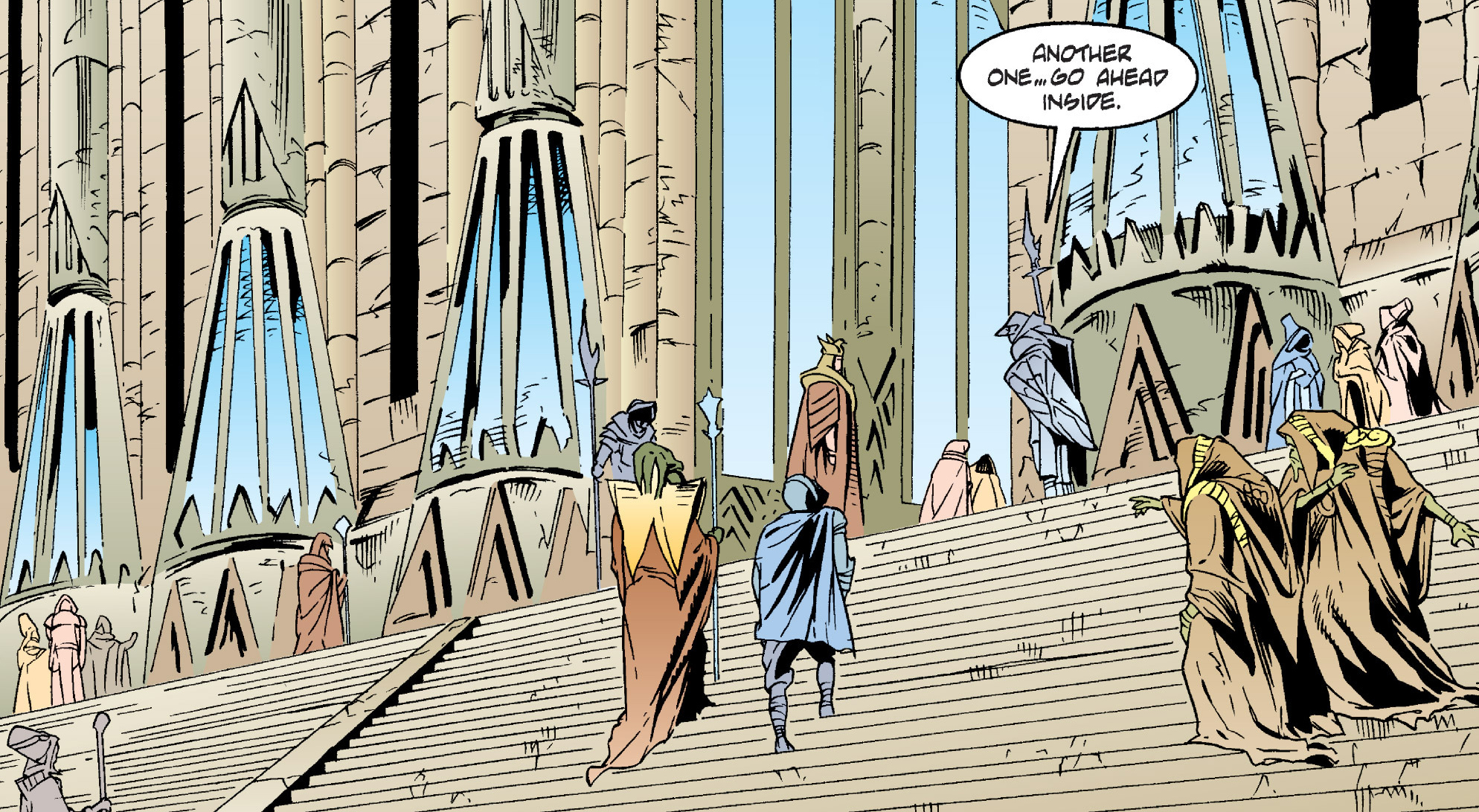
The Senate Hall.
Around 12,000 BBY, Contispex I became Supreme Chancellor. He and his descendants belonged to the theocratic Pius Dea cult that would control the Republic for the next 1,000 years. These fanatic Supreme Chancellors sanctioned "crusades" against rival alien sects in the Rim. After 11,000 BBY the cult may have violently dissolved. The tensions from the fallout of the crusades would deepen the rifts between the Core Worlds and those of the Rim, which Emperor Palpatine would exploit during his reign millennia later.
Around 9000 BBY, Blotus the Hutt became Supreme Chancellor and ruled the Galactic Republic for 275 years during the Rianitus Period. Unlike most other Hutts, Blotus was a distinguished and just ruler. At least by 7308 BBY, the Galactic Standard Calendar was fixed.
In 7003 BBY, the Second Great Schism occurred when a group of fallen Jedi discovered a Force technique that could alter lifeforms. This started the centuries-long Hundred-Year Darkness, which saw the creation of monstrous creatures, most notably the serpentine Leviathans, which drew life-energies into blister-traps on their backs. At the Battle of Corbos in 6900 BBY, the Jedi crushed the rebellion and banished these fallen Jedi from known space. However, the fallen Jedi discovered Korriban, a desolate world inhabited by the relatively primitive but unusually Force-sensitive Sith people.
Using their training in the Force, the fallen Jedi amazed the Sith and elevated themselves to god-like status on nearby Ziost, becoming the rulers of the Sith people. As years passed, and interbreeding occurred between the fallen Jedi and the Sith, the term "Sith" came to mean not only the original inhabitants of Korriban and Ziost but also their fallen Jedi masters.
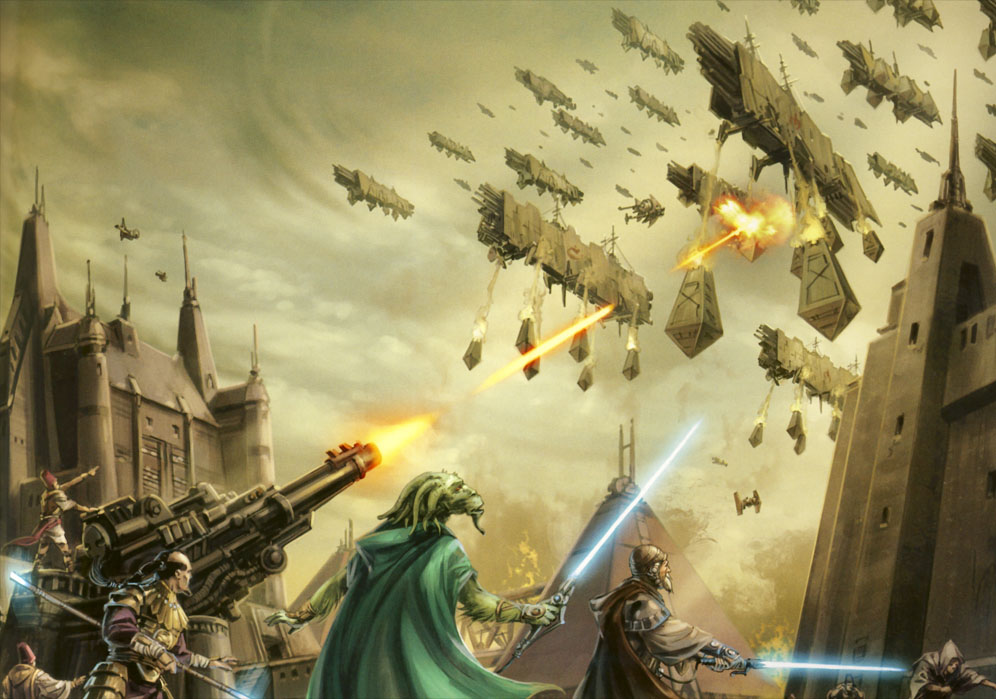
Coruscant, the Galactic capital, assaulted during the Great Hyperspace War.
In 5000 BBY, the Jedi and the Old Sith Empire clashed in the Great Hyperspace War. Many worlds were forever scarred in that battle, but the Jedi were able to repulse the invaders. After that, the Republic granted the Jedi land over a Force nexus: a sacred mountain on Coruscant over which the Jedi Temple was constructed. The Sith were defeated in that same year but not destroyed.
In 4250 BBY, the Third Great Schism occurred, which involved fighting on Coruscant. The surviving Dark Jedi were forced to flee to the Vultar system, where they discovered ancient technology indicating that the system's worlds were artificial constructs, probably the creations of the mysterious Celestials who had also built the Corellian system. These Dark Jedi took over these machines, including the Cosmic Turbine, but could not control them, and soon destroyed the whole system and everything in them during the Vultar Cataclysm. Around 4000 BBY, four Jedi Masters (two Warrior Masters and two Sage Masters) established the ziggurat of the Jedi Temple over the Force nexus on Coruscant, which would stand for over four thousand years.
The year 4015 BBY saw the Great Droid Revolution on Coruscant, led by HK-01, who was eventually defeated by Arca Jeth and the Jedi. During the conflict, Arca Jeth discovered techniques for disabling machines through the use of the Force.
Following those conflicts were those of the Old Sith Wars, that began of c.4000 BBY which almost destroyed the Republic. During the Great Sith War (4000 BBY–3996 BBY), the Sith Lords Exar Kun and Ulic Qel-Droma, along with their Krath and Mandalorian allies, waged war on the Republic with their own Sith Empire, causing devastation until they were defeated by the combined Jedi and Republic forces. Afterward, the Cleansing of the Nine Houses and subsequently the Great Hunt occurred (3995–3993 BBY).

Republic and Mandalorian fleets clash at the Battle of Vanquo.
These would be followed by the Mandalorian Wars (3976—3960 BBY). They were fought between Mandalorian forces hoping to expand their colonies beyond the Outer Rim Territories and the Galactic Republic, which feared further incursions. The Mandalorian Wars were a prelude to the more devastating Jedi Civil War (3959–3956 BBY). The Jedi Civil War, also known to some as the War of the Star Forge, was fought between the Republic and the Sith Empire under Darth Revan and Darth Malak. It was possibly the most destructive conflict of that entire era, with many worlds, including Taris, Dantooine, and Telos IV, being devastated by the Sith fleet. After the Jedi Civil War and the fall of the Sith Empire, the Sith remnants fought each other, exterminated the remaining Jedi and waged a secret war with the Republic, until the Battle of Malachor (3956-3951 BBY). One year later, the Sith Civil War ended, bringing the Old Sith Wars and the Sith Empire to an end. Some time later, a sole survivor on Korriban began the rule of two by finding a Sith Apprentice.
In 3900 BBY, Queen Elsinoré den Tasia of the Core World of Grizmallt sponsored an expanding fleet of three vessels—Beneficent Tasia, Constant, and Mother Vima. This fleet was led by the Republic explorer Kwilaan and would discover the planet Naboo.
From 3970 – 3670 BBY, the Kanz Disorders took place in the Kanz sector. During that time, the Provisional Governor Myrial of Argazda seceded from the Republic and established a military regime throughout the Kanz Sector. During the conflict that followed, her military forces invaded planets that resisted her reign throughout the Kanz Sector, including Lorrd. She often enslaved their inhabitants, most notably the Lorrdians of Lorrd.
The enslaved Lorrdians were forbidden by their masters from communicating with each other. As a result, they were forced to develop a system of subtle gestures, facial expressions, and body postures to talk to each other. This nonverbal form of communication would still be in use over four millennia later. After three centuries and the loss of over five billion lives, including those of some 500 million Lorrdians, the Kanz Disorders finally ended when Jedi/Republic efforts toppled the regime in 3670 BBY.
In 3700 BBY, the pioneer woman and Brentaal IV native Freia Kallea discovered the Hydian Way, which spanned the entire north-south width of the galaxy. This allowed the Republic to expand past the Slice into the worlds of the Mid and Outer Rims, and also led to the discovery of more hyperspace routes, including the Corellian Trade Spine, thus starting the .
Symbol of the Republic during the Sith Empire's return.
In 3681 BBY, the Sith Empire returned to wage war against the Republic in the Great Galactic War. The War greatly weakened the Republic, culminating in the Sacking of Coruscant and the signing of the Treaty of Coruscant in 3653 BBY. The Treaty of Coruscant placed several major burdens on the Republic. A large economic depression began, slowing the rebuilding process and stalling efforts to restore peace. The Treaty of Coruscant also forced the Republic to abandon many long-time allies, including the Bothans. The Republic was forced to relinquish control of many planets to the Empire, such as Balmorra. As a result of the Great Galactic War and its subsequent treaty, which left the Republic in an unfavorable position, many star systems began withdrawing from the Republic. The Mantellian Separatist Movement took over Ord Mantell, beginning the Separatist War, while Alderaan seceded from the Republic altogether, beginning the Alderaan Civil War. The Republic was plagued with an insurmountable supply crisis and chaos in the streets of Coruscant, and the Senate was left paralyzed. Confused by the chaos, the insolvent Senate blamed the War and its current problems on the Jedi, sparking a feud with the Order that saw their departure from Coruscant and relocation to their ancestral homeworld of Tython. After the Great Galactic War, after the signing of the treaty of Coruscant, the Cold War began, lasting for 11 years before the tense peace collapsed around 3642 BBY, beginning the Galactic War, which began to conclude around 3637 BBY with a temporary truce between the Empire and the Republic during the re-emergeance of the Revanites with Revan in lead. It finally ended in 3636 BBY during the Eternal Empire conquest, in which the Galactic Republic and the Sith Empire had to submit to the new power and were forced to pay huge amounts of resources. The Republic and the Sith Empire were liberated with the defeat of the Eternal Empire at the hands of the Outlander and their Eternal Alliance. Shortly after, tentions escalated again between the two side during the conflict on Iokath, and later into an all out war after the Sith Empire's assault on the Jedi colony on Ossus.
At an unspecified point in galactic history, the Sith Empire would eventually fall, with Darth Desolous having set up his own faction over a century after the Eternal Empire's invasion. In 3000 BBY, the Seventeenth Alsakan Conflict ended with the final defeat of Alsakan, and the introduction of the Invincible-class Dreadnaught into the Republic fleet.
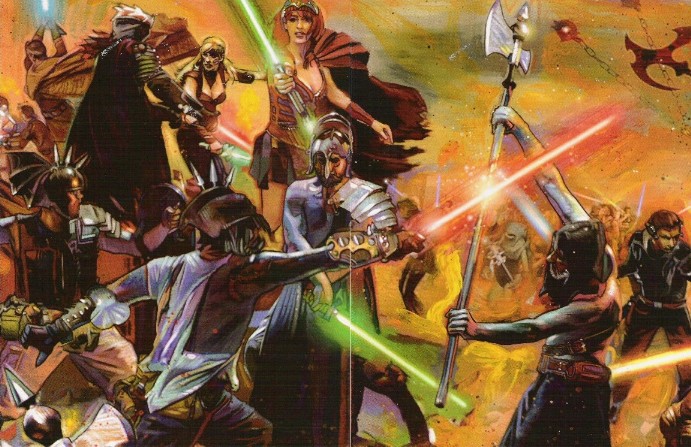
The Ruusan campaign put an end to the Sith threat.
In 2000 BBY, the Republic once more faced the menace of the Sith with the fall of Darth Ruin and the rise of the New Sith Empire. This time, the Jedi took the forefront of the war against the revived order. The conflict with the reborn Sith Empire fluctuated over the course of hundreds of years until the Battle of Mizra in 1466 BBY, which saw one of the largest Sith victories in the entire war. The losses for the Republic were so catastrophic that a dark age began, with widespread social unrest and economic collapse.
The Republic itself shrunk to a mere rump state surrounding the Core Worlds, Inner Colonies, and few other worlds outside it, with the Sith Empire encompassing virtually the rest of the entire galaxy. The Jedi took over absolute authority, ruling the remainder of the Republic directly. The Senate was bypassed, with sole governing power residing in the Jedi, while the Republic's armed forces were absorbed into the Jedi Army of Light.
After nearly five hundred years of continued war, the Army of Light had beat back the Sith to the planet Ruusan. They were finally defeated in 1000 BBY at the Seventh Battle of Ruusan, although almost all the forces of the Army of Light that were on Ruusan also perished. The lone Sith survivor, Darth Bane, subsequently initiated the Rule of Two, meaning that at any given time there would only be one Sith Master and an apprentice. They continued this method over the next millennium, in secrecy, waiting patiently for the right moment to bring down the Jedi.
Following the battle, the Ruusan Reformation was enacted by Chancellor Tarsus Valorum. It returned power to the Senate, placed the Jedi under the authority of the Republic government, and disbanded the vast majority of its remaining military.
At long last, with war after war, peace and prosperity came to the Republic. Yet with it came a dangerous complacency. Vast armies and navies were downscaled, and the Republic came to rely on the Jedi more and more for the maintenance of civility. Despite a few isolated flashpoints—like the Stark Hyperspace War and the Battle of Naboo—full-scale military conflict remained a distant memory.
Nonetheless, remote planets theoretically under the jurisdiction of the Republic hardly could find the technology that was commonly available near the Core. Feeling little interest for those planets, the Republic did not even chart them properly or classify all of their flora and fauna.
As the Republic grew more and more powerful, many of the bureaucrats and Senators that ran the government grew increasingly corrupt or complacent. The bureaucracy that had grown and festered over millennia choked any attempt at effective government. Furthermore, patron politics and personal agendas also hampered effective governing, and due to the increasing collusion of decadent governmental agents and politicians with favored groups, corporations like the Trade Federation and Techno Union grew in power and even formed their own militaries. It is likely, given the eventual result of this decline, that it was nurtured and accelerated (and perhaps even started) by the Sith during the centuries they spent in hiding after the Battle of Ruusan.
The Bendu-inspired symbol used during the later stages of the Clone Wars.
During this time (32 BBY) the Senator of Naboo was Palpatine. His homeworld was under siege by the Trade Federation. Despite the full-scale invasion of the planet, the call to condemn the invasion was tied up in bureaucratic procedure. When Queen Amidala—the elected leader of the sovereign system of Naboo—spoke before the Senate, calling for action, she also called for a Vote of No Confidence in the leadership of the Republic, under the persuasion of Palpatine, and Chancellor Finis Valorum was voted out of office. This led to the increasingly-popular Palpatine's election as the Supreme Chancellor of the Republic.
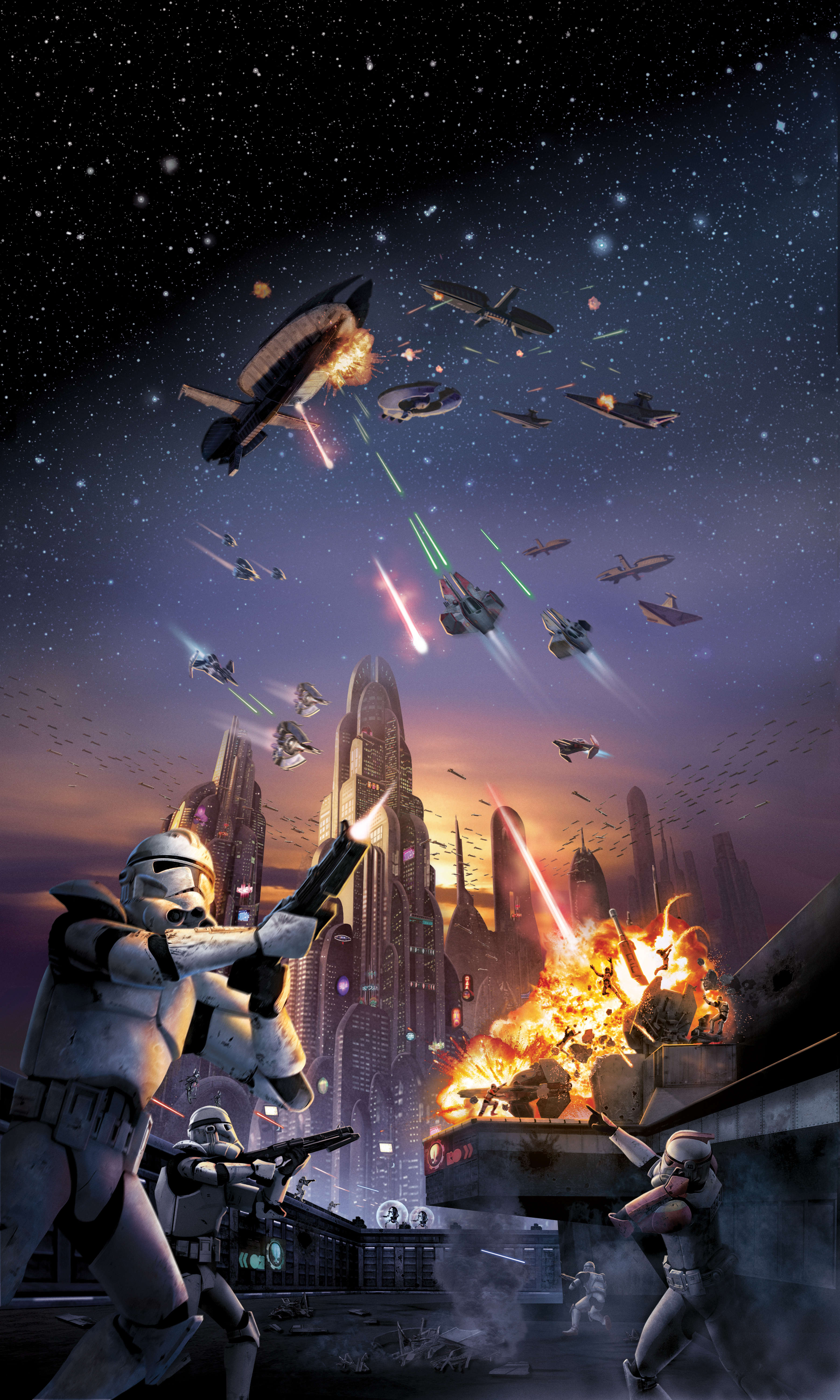
Coruscant under attack during the last phase of the Clone Wars
Traditionally, the Chancellor could only serve two four-year terms, but Palpatine stayed in office much longer, due to the prolonged Separatist Crisis, that began on Raxus Prime in 24 BBY.
The crisis occurred when several of the Republic's star systems and commercial organizations, fed up with the corruption and obliviousness to their issues and concerns in the Republic, united in order to separate from the Republic. This unified front became known as the Confederacy of Independent Systems. Tensions between the Republic and the Separatists eventually escalated into all-out war after a Jedi strike team came to Geonosis, which started the First Battle of Geonosis—and the Clone Wars, that began in 22 BBY. The Senate granted Palpatine emergency powers to deal with the Separatist Confederacy in a motion introduced by the Naboo representative Jar Jar Binks. Palpatine's first move, widely supported at the time, was to create a vast army of clone warriors to serve as the Republic's fighting force against the Confederacy. The Republic had not previously needed an army since until then any small conflicts within the Republic could be solved by recourse to the peacekeeping Jedi, or to local navies and militias. However, the fact that the Confederacy had access to an enormous army of droid soldiers required the Republic to construct a more formal federal military in order to effectively fight.
However at least one enemy of the Republic managed to turn away from the CIS and ally itself with the galactic government, it was Jabba Desilijic Tiure's criminal empire, for rescuing their leader's son, secretly held captive by the Separatists, thus the Republic had some advantage over the CIS during the war. Along with their allegiance with the Hutts, the Republic was allowed the use of the Hutts' hyperspace lanes.
In the ensuing years, the Senate increasingly gave more power to Palpatine, who became the war's political Commander-in-Chief. Such actions were justified in the name of security, and eventually, Palpatine did not need the approval of the Senate for many of his actions. Since the Chancellor held the loyalties of a vast majority of supporters in the Senate, this was considered a perfectly reasonable way to increase the wartime government's efficiency. The citizens of the galaxy, who had long since lost faith in the corrupt and inefficient Republic itself, came to see Palpatine personally as their protector from the droid armies and their terrible commander, General Grievous.
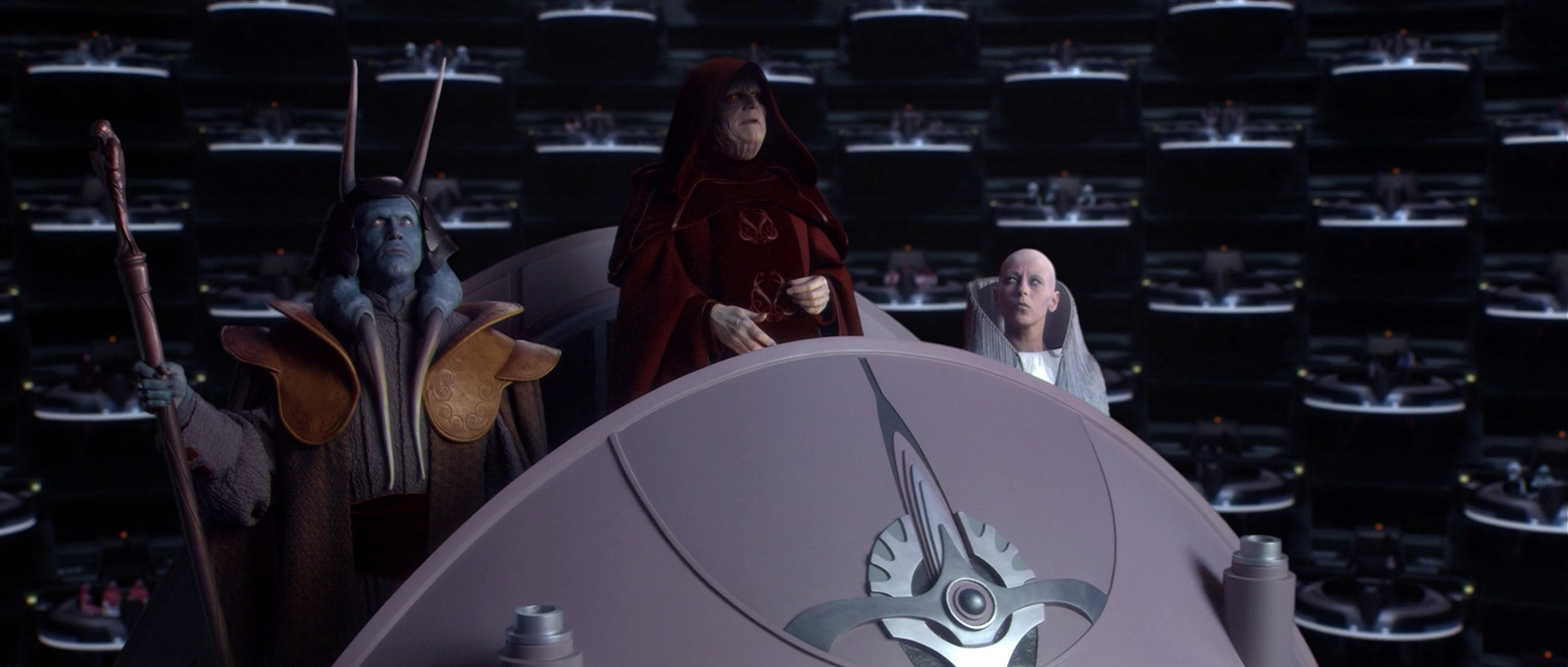
Palpatine replaces the Republic with the Galactic Empire.
The tension between Chancellor Palpatine and the Jedi Order grew as the Council became increasingly wary of the Chancellor's lust for greater power. As the Chancellor continued to increase his authority through a variety of emergency powers, the Council became ever more suspicious of Palpatine's intentions and ultimately disapproved of the Republic's gradual slide into autocracy, especially at the expense of the Senate—the only governmental body that the Order was legally obligated to serve.
With the help of Anakin Skywalker, the Council discovered that Palpatine was actually the elusive Darth Sidious, Dark Lord of the Sith, and thus they conspired to arrest the Republic's own head of state. The Jedi coup d'état ended in failure, however, when Palpatine killed all four of the Jedi Masters, including Mace Windu, that tried to take him into custody. He then responded by declaring all Jedi as enemies of the Republic and won the Senate's support after portraying them as assassins bent on taking over the Republic. Through Order 66, the Chancellor realized the Sith's long-awaited dream of the Jedi Order's destruction. Without warning, the clone troopers of the Grand Army betrayed and murdered most of their Jedi officers.
As the Clone Wars ended with the onset of the Great Jedi Purge in 19 BBY, Palpatine addressed the Senate and declared the rise of a New Order, beginning with the Republic's immediate transformation into the Galactic Empire. Palpatine, who had been grotesquely disfigured during the attempt on his life, proclaimed himself emperor of the galaxy, thus transforming the office of the Supreme Chancellor into what it had already become—an absolute dictatorship. Deluded by Palpatine's charm and skill, in conjunction with the effects of his dark side powers of persuasion, the majority of the Senate cheered him on loudly in approval. Soon afterward, industries were nationalized and the Republic was replaced by the authoritarian Empire, ruled by a megalomaniac autocrat.
The emblem of the Galactic Empire was a redesign of the Old Republic's symbol.
After more than 25,000 years, the Galactic Republic had ceased to exist. Only a shrunken, powerless Imperial Senate remained as the last symbol of the old galactic government. Prior to its dissolution two decades after the rise of the Empire, the Senate was nothing more than an ineffective advisory board that Palpatine tolerated until his reign was consolidated enough for him to rule without the stagnant bureaucracy. With the last remnant of the Old Republic destroyed by the very man whom they supported, the Senate's responsibilities were redirected to the Moffs and regional governors, all of whom were empowered to rule over their respective territories in the name of Emperor Palpatine.
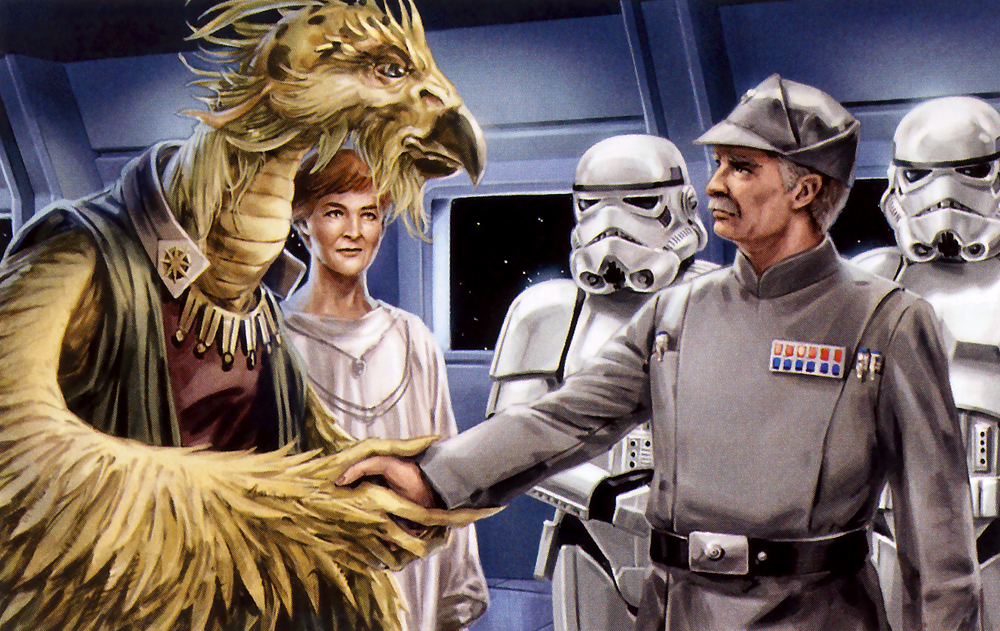
After decades of Imperial oppression, the restoration of the Republic is officially recognized with the Empire's capitulation.
Barely a year into the reign of Emperor Palpatine, the Empire's precursor state became known as the "Old" Republic, mainly to emphasize the various excuses behind the Republic's fall and the creation of the Empire. Though the Emperor focused much of his reign towards the gradual elimination of all remaining symbols that reminded the Imperial populace of their democratic past and heritage, the long history and cherished principles of the Old Republic were secretly held dear by a growing number of Imperial citizens that became disillusioned with the Empire due to the oppressive measures that Palpatine enacted to further strengthen his hold over the galaxy.
By 2 BBY, the Emperor's tyranny motivated several dissidents within the Imperial Senate to create the Alliance to Restore the Republic, thus initiating the Galactic Civil War. Two years later In response to the insurrection, the empire abolished the senate, which had officially left the rebellion as a separate galactic government from the empire. Four years later, the deaths of both Emperor Palpatine and Darth Vader at the climactic Battle of Endor enabled the struggling Alliance to rebound from certain defeat while the Empire descended into chaos and disorder.
In the following week, the Rebellion fought in the Bakura Incident, immediately after that conflict the Alliance to Restore the Republic, was reorganized into the Alliance of Free Planets, in the following month, the Alliance of Free Planets fought in the Nagai Tof War and immediately after that conflict, the new alliance, was reorganized into the New Republic. In 6.5 ABY, the New Republic, took Coruscant, twice, from the local Imperial faction, thus the restored Republic had officially claimed authority over the galaxy. In 11 ABY, the New Jedi Order was created in the Jedi Praxeum, on Yavin 4. After the Imperial Reunification in 12 ABY, the Imperial Civil War had ended and unified the feuding Imperial factions into the Imperial Remnant. In 19 ABY, the New Republic and the Imperial Remnant signed a peace treaty that ended the Galactic Civil War, fifteen years after the Battle of Endor.
The memory of the Old Republic, along with many of its ideals, was further carried on after the New Republic reorganized itself into the Galactic Alliance, due to the four-year war with the extra-galactic Yuuzhan Vong, who themselves had briefly taken over the galaxy.
In 44 ABY, at the aftermath of the Lost Tribe War, the Imperial Remnant, was reorganized into the Fel Empire and about a month later, the galaxy's Second Cold War had began, this time between the newly restored Galactic Empire and the Galactic Alliance, which would last for several decades. In 127 ABY, the truce, between the Imperials and the Alliance was broken, when the Sith came out of hiding and declared war on the Galaxy, where the Fel Empire's influence increased significantly. In 130 ABY, the Fel Empire had finally taken over the Galaxy and the three-year war had come to a halt.
Their dominance was short-lived to a few months, when the resurrected Empire was overthrown by the Sith in a coup, in which they renamed it Darth Krayt's Galactic Empire, which divided the previous government into the Empire in exile and the Galactic Alliance Remnant, who began the Second Imperial Civil War and the Third Jedi Purge. In 138 ABY, Darth Krayt's Galactic Empire was taken down by an allegiance of the Galactic Alliance Remnant, the Empire-in-exile, and the fragmented New Jedi Order and created the new democratic government, known as the Galactic Federation Triumvirate. In 139 ABY, the GFT, would defeat the Sith, but their secular alliances, continued to fight the GFT for well over a year, until their own surrender in 140 ABY. Following the end of all these conflicts, the galaxy, had entered an era of peace and unity.
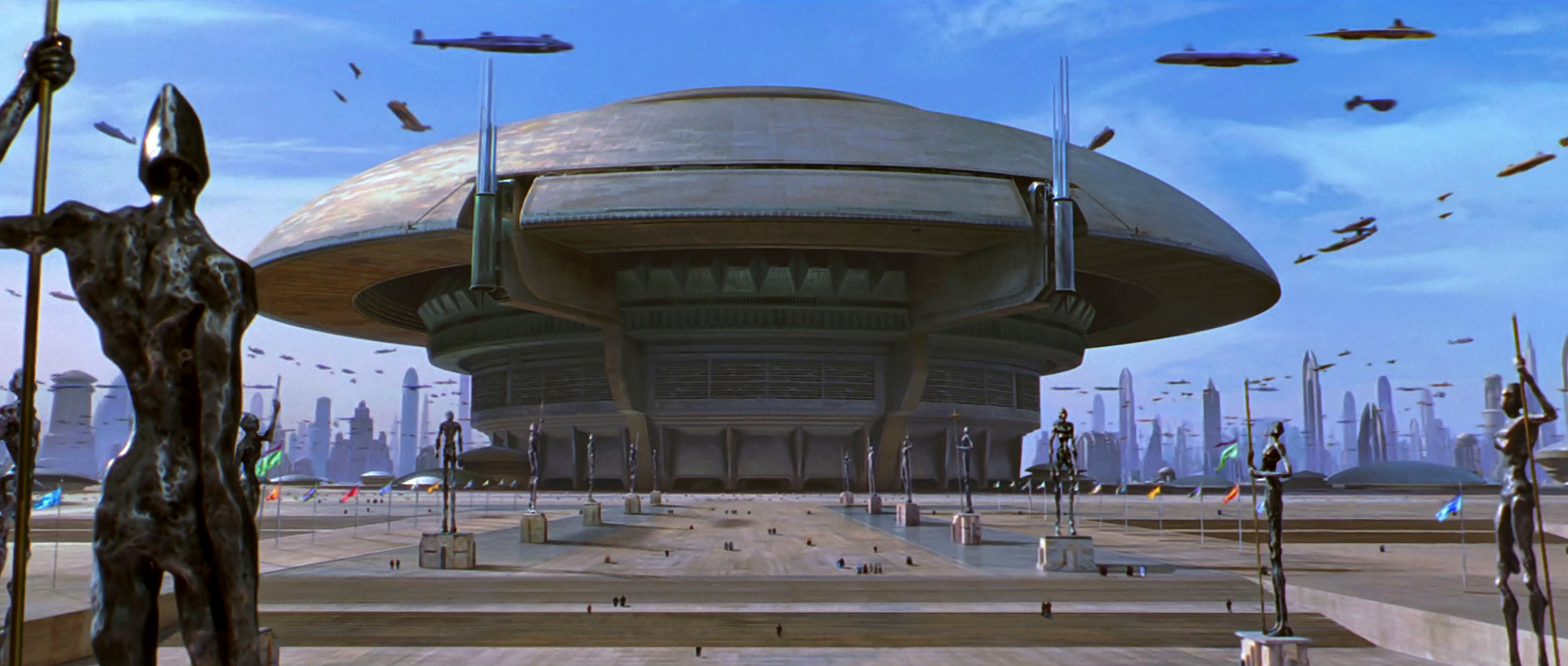
The Senate building, behind the Avenue of the Core Founders.
The Republic began as a mutual protection and economic alliance among a number of planets in the galactic core. The Republic's greatest failing was its lack of formal organization. Much of its operation was based on nonbinding constitutional conventions, which were more often ignored and undermined by corrupt and power-hungry politicians than heeded. Coalition governments were common, with special interests defining the legislative agenda. The Senate, in the later years of the Republic, was so ineffectual that many politically connected corporations and informal blocs of ideologically like-minded planets could essentially do what they wanted; corrupt governmental bodies even made it possible for certain entities, such as the Trade Federation, to construct de facto sovereign and immense military forces.
However, the waning years of the Republic were a time of corruption and great social injustice. The Senate became divided between those who genuinely wished to uphold the values and ideals of the Republic and those who wished to further their own goals. After a series of weak and ineffectual Chancellors and a crisis involving the invasion of the planet Naboo by the Trade Federation over a tariff passed in the Senate, the time had come for strong leadership to end the corruption.
Within the government, much of the bureaucracy was handled by the General Ministry. Within this body were the Ministries of , Intelligence, Commerce, Defense, Education, Finance, Licenses and Permits, Public Information, Science, , Internal Security, and .
Each member state (system governments) returned a representative (a senator) to a central legislative body (the Senate). Senators were the ambassadors of their homeworlds, and member worlds were able to maintain their government and society in accordance with local beliefs, customs, and traditions. There was a wide variety of different local governments along the political spectrum: from monarchies to republics to hive-like communes. In some systems, the senator was elected to that post; in others, the world government appointed the senator. Naboo's monarch appointed their senators, while the Alderaan Council of Elders elected their senator out of their own ranks (usually the heir to the Royal House of Organa, as the heir, was also the leader of the council).
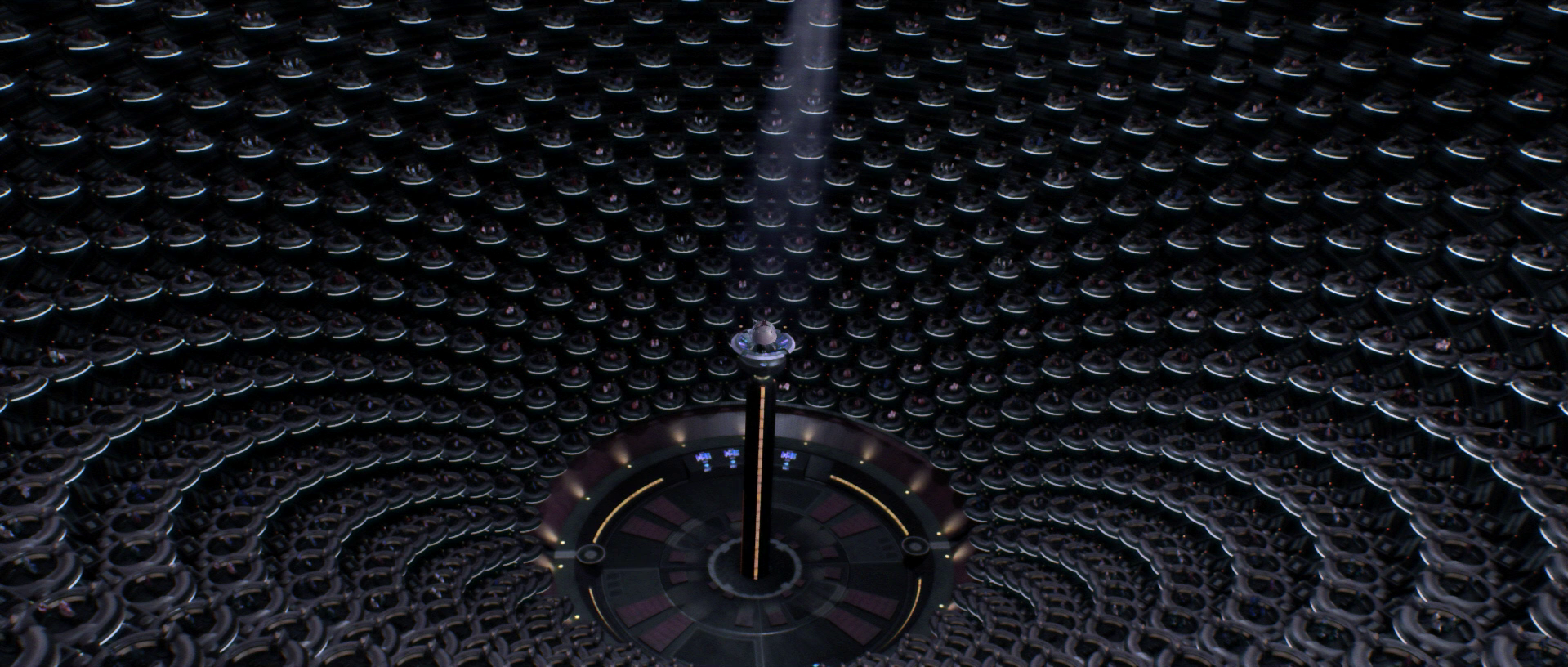
The Senate Rotunda.
When the Republic's power and influence expanded, many new areas of the galaxy were incorporated into the Republic. A reorganization of senatorial representation occurred in the year 1000 BBY, during the Ruusan Reformation. The most common organization for these new territories was to group regions into sectors of approximately fifty inhabited worlds. Each sector was represented by a senatorial delegation. When the number of senators became too large, sectors were organized into roughly a thousand regions, each represented by one delegation to the Senate.
The Senate was headquartered in an enormous building containing many floating platforms, each of which contained several senators. Each platform in the Senate represented a "sector" of the galaxy, with one senator from each planet in that sector. Some platforms represented individual worlds, others the powerful corporations and guilds such as the Trade Federation. Along with the senators, the leaders of the individual member planets also had the power to vote in the Senate and introduce legislation. The Senate followed such parliamentary rules as a Vote of No Confidence, such as that introduced by Queen Amidala of Naboo which forced Chancellor Finis Valorum out of office in 32 BBY.
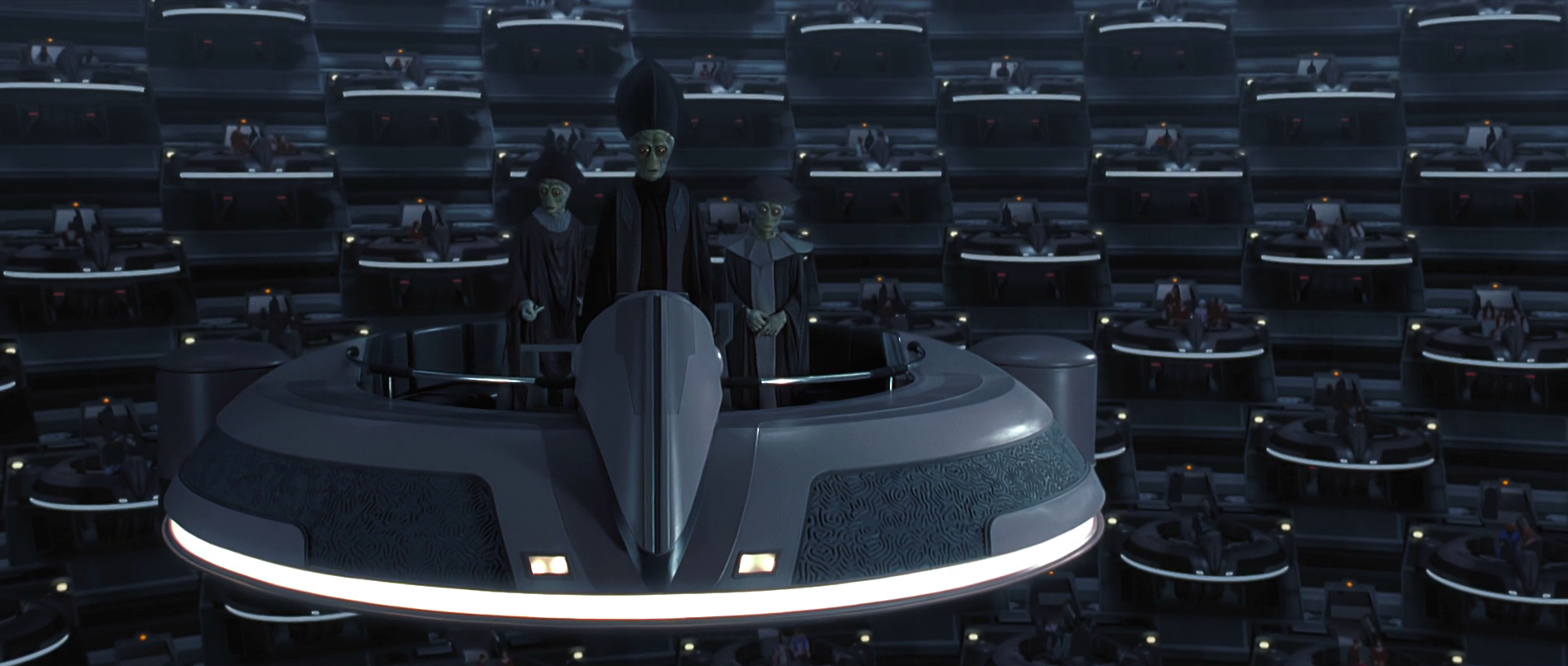
Senator Lott Dod of the Trade Federation addresses the Senate.
Senators received one vote in all matters—procedural and substantive. The Chancellor was elected from within the Senate. The assembly was in turn divided into individual committees, each specializing in specific fields of government administration, and which were responsible for creating legislation to be reviewed by the full assembly.
Although legislation passed by the Senate was binding to all member worlds, most of the everyday legislation followed by citizens of the Republic was created at the planetary, sector, or regional level. Therefore, the main functions of the Senate were to mediate disputes between members, provide for the common defense, and regulate inter-system trade.
The members of the Senate would then elect a Supreme Chancellor from amongst their ranks who would serve as the Republic's head of government (and, by default, head of state) and chief diplomat.
The office was largely powerless in the last years of the Republic, especially after the Ruusan Reformation, and the Chancellor served mainly as an officiator of parliamentary procedure and the first among equals in the Senate. However, it had the authority to call an Extraordinary Session of the Senate and could invoke "Chancellor's prerogative" in circumventing minor aspects of the Senate's parliamentary procedure. He also was the head of the Senatorial Council.
It was still a very prestigious position, however, and the Chancellor had a grand office in both the Senate Rotunda's Chancellery and in the dome-like Senate Office Building in Galactic City. The Chancellor was properly addressed as "Your Excellency." The symbol of the office of the Chancellor, as well as the Galactic Senate as a whole, was a fanned spear. This cygnet was also emblazoned prominently on the Chancellor's podium in the center of the Senate Rotunda's Main Chamber. When in the Main Chamber, the Chancellor usually wore a Veda cloth robe. The Chancellor was elected from among the senators who made up the Galactic Senate and served a term of office that lasted for four standard years. A Chancellor could legally serve only two consecutive four-year terms before he or she had to step down due to term limits.
The office became much more powerful during the term of Chancellor Palpatine, who was able to convince the Senate to grant him a range of "emergency" powers due to the Separatist Crisis and then the Clone Wars, including an unconstitutional extension of his term of office after 24 BBY for the duration of the Separatist Crisis and authority as commander-in-chief of their new military during the Clone Wars. The Chancellor was given more direct power over administrative concerns, and he was allowed to overrule local planetary and sectoral governments. The Sector Governance Decree allowed him to appoint military governors to every planet in the Republic, and the Security Act amendment gave him complete control over the Jedi Order and Republic military, stripping both the Jedi and the Senate of their previous oversight.
Eventually, Palpatine became a dictator and proclaimed himself Emperor of the galaxy, thus abolishing the office of Chancellor and transforming the Galactic Republic into the Galactic Empire. The position was not revived by the New Republic, which chose instead to call its chief executive the Chief of State. Ironically, Palpatine's thirteen years in office, added to his reign as Galactic Emperor, forever tainted the once noble and prestigious position of Chancellor so much so that it was far too controversial to revive in the New Republic even though before Palpatine it had been a symbol of good in the Old Republic.
The Supreme Court was the highest court of law in the Old Republic and composed the judicial branch of the Republic's government. The Supreme Court was headquartered in the Galactic Courts of Justice Building on Coruscant. The Court consisted of twelve justices (each addressed as "Your Honor"); one of them was the Chief Justice who headed both the Court and the judicial branch. The Supreme Chancellor nominated judges to the Court and the senate had to approve the nominations, while the nomination of the Chief Justice had to be confirmed by the judges of the Court. In addition to serving as a "court of last resort" and as a determiner of constitutional legality, the Supreme Court also tried cases involving the highest politicians and most noteworthy people in the Republic. However, at least some cases (including the trial of senators for treason) were handled by the Senate.
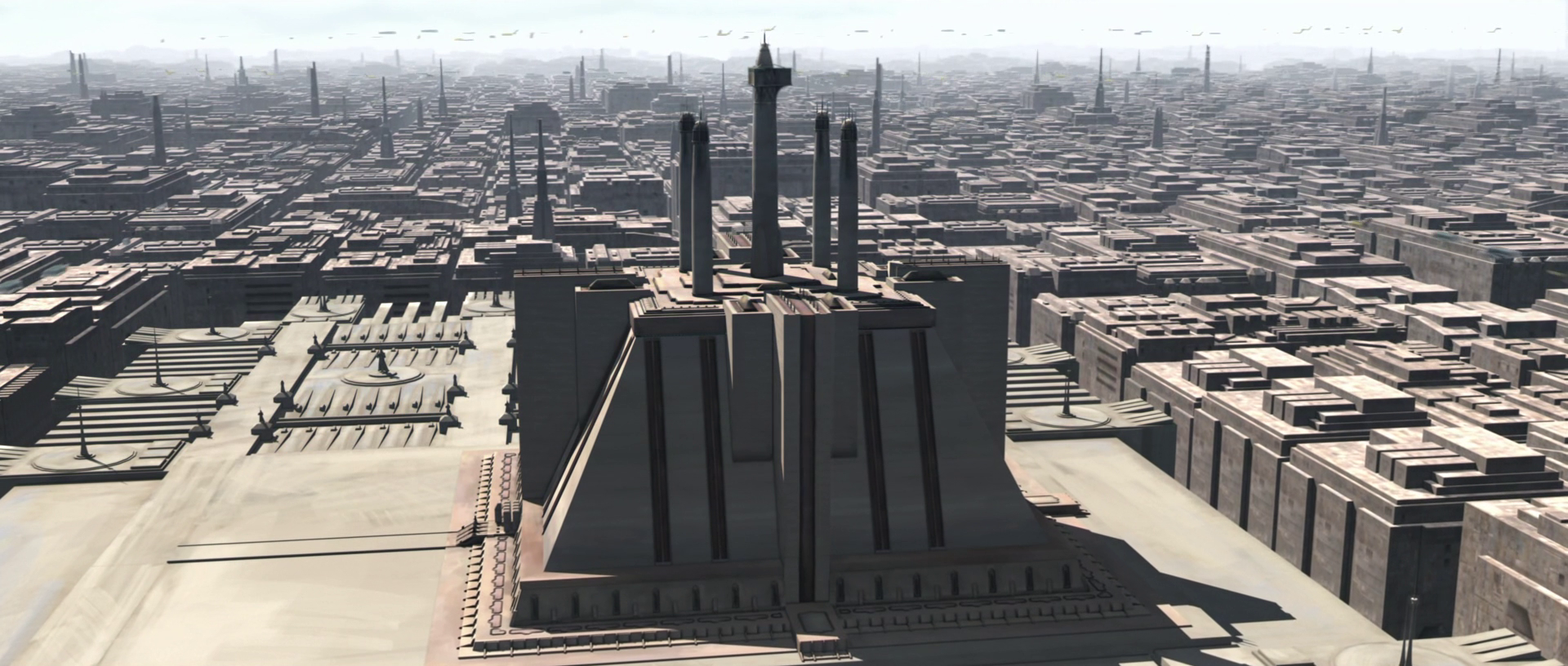
The Jedi Temple, headquarters of the Order on Coruscant.
When the formation of the Galactic Republic occurred in 25,053 BBY, the Jedi Order had already existed for several hundred years on the planet Tython. Within a century since the Republic's conception, the Order pledged its support for the new government, and thus became formally answerable to the Galactic Senate. But despite the Jedi's allegiance to the Senate, the Order had always enjoyed a great degree of autonomy to act as they saw fit, especially regarding internal Jedi affairs. Nevertheless, for thousands of years the Jedi Order's members consistently served the Senate in a variety of capacities—whether as special emissaries, peacekeepers, or warriors.
But as the Republic gradually expanded its sphere of influence over the known galaxy, the unprecedented level of peace and prosperity also led to a virtually irreversible trend in corruption, decadence, and stagnation, especially amongst the elected officials of the Senate. Yet throughout all of that time, the Jedi Order maintained its traditions and principles, often acting as a beacon of honor and integrity within a society that was becoming increasingly amoral and unjust. The Republic government's decline into greed and complacency was not lost on the Jedi either; many within the Order loathed the thought of being accountable to an ineffectual system that was too large and disorganized to effectively counter the growing list of problems that plagued the Republic and its citizens.
Throughout its long history, the Jedi were forced to intervene on "behalf" of the Senate by diffusing internal and external threats to the Republic's stability. During the New Sith Wars, the Order was even forced to take a more "hands-on" approach to government itself, mainly by commandeering the executive office of Supreme Chancellor due to the Senate's inability to counter the danger that the Sith posed to Republic primacy throughout the galaxy; it would take an entire millennium before the Jedi could risk leaving the government to its own devices once more.
After the Sith were presumably destroyed in the conclusion of the Seventh Battle of Ruusan, the Jedi Order was able to enjoy a thousand years of keeping the peace throughout the Republic without having to worry about another galactic-scale war. Though the demilitarization of the Republic armed forces placed an even greater burden on the Order, the Jedi handled their responsibilities well enough to ensure that the Republic's stability was not threatened by the sudden lack of a strong military force.
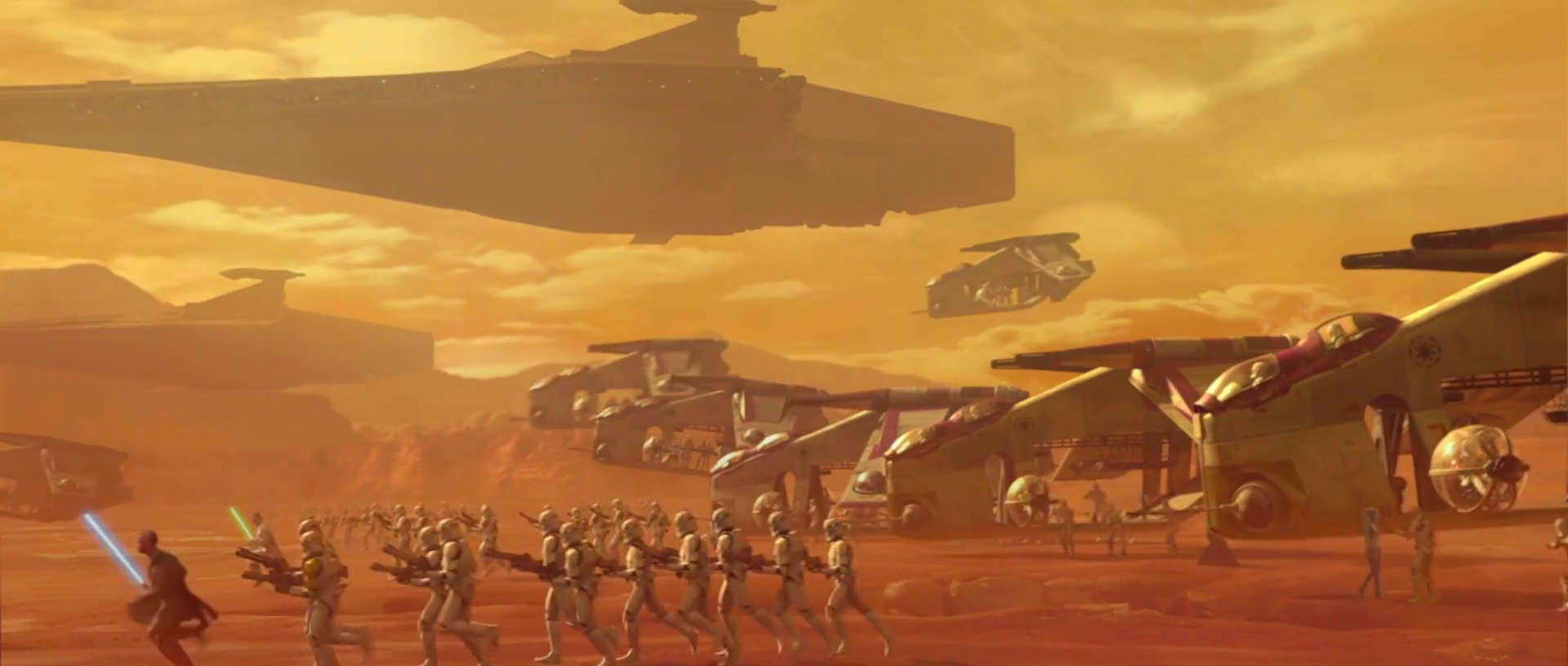
When necessary, the Jedi defend the Republic on behalf of the Galactic Senate.
As the Republic reached the twilight of its existence, relations between the Jedi Order and the galactic government on Coruscant had grown strained more than ever. The Senate was filled by a large majority of self-serving delegates who cared nothing for the troubles of their constituents, effectively reducing the few honest members to an ineffective collection of senators with little hope of restoring honesty to the august body. The Jedi Council grew ever more disdainful of the Senate to the point where they believed that no politician could ever be trusted. Likewise, the Senate began losing faith in their ancient protectors. As the Separatist Crisis worsened to the point where the galaxy was on the verge of being split in half, many senators came to doubt the Order's ability to safeguard the Republic or its government.
Despite the evident animosity between the Order and the legislature, the Senate wasted no time in commissioning the Jedi as officers in the newly formed Grand Army of the Republic. Throughout the conflict with the Separatists, the Jedi Order acted once more as the Senate's armed instrument by leading millions of soldiers and amassing countless victories on various battlefields throughout the galaxy. But even as the Jedi championed the Republic cause and led its army to ultimate victory over the Separatists, the relationship between the Order and the Senate was nowhere near any improvement. The tension reached its climax when the Jedi Council contemplated seizing control of the Senate, an action they would have only had to take had they removed Chancellor Palpatine from office by force. Hence, the Council had evidently lost all faith in the Senate's ability to preserve the Republic's stability in a time of crisis.
After the Council failed to arrest Palpatine, the public facade of the Sith Lord Darth Sidious, the Senate did not hesitate to rid itself of its Jedi guardians by doing nothing as the Great Jedi Purge commenced with Order 66 and Operation: Knightfall. With the Jedi virtually neutralized, and with the Senate under the control of the Sith, Palpatine easily reorganized the Republic into the first Galactic Empire with himself as emperor. Throughout Palpatine's Declaration of a New Order, the vast majority of the Senate applauded the extremely radical amendments that officially brought an end to a Republic that had existed for over 25,000 years. At the same time, the Jedi were being hunted down and annihilated by the Empire while the Senate made no attempt to intercede on behalf of the organization that had protected them since the founding of the Republic. For thousands of years, the Jedi Order stayed true to their allegiance to the Galactic Senate, even in the worst of times when the legislature reached the zenith of its corruption, only to be betrayed and abandoned by the elected officials that they were sworn to serve and protect.
When the Senate was reformed after the fall of the Empire and the rise of the New Republic, the undeniable advantages that the Jedi contributed to the Old Republic convinced the New Senate to promote the restoration of the Jedi Order. Throughout most of its history, the Jedi Order personified the nobility of the Galactic Republic; the mere existence of the Order enabled the Republic to exist as the pinnacle of galactic civilization in spite of an incredibly corrupt and inefficient legislature. Without the Jedi Order, the Republic would have collapsed under the Senate's dead weight long before its time—a fact that was proven when the near elimination of the Jedi allowed Darth Sidious to transform the Republic into the Empire.
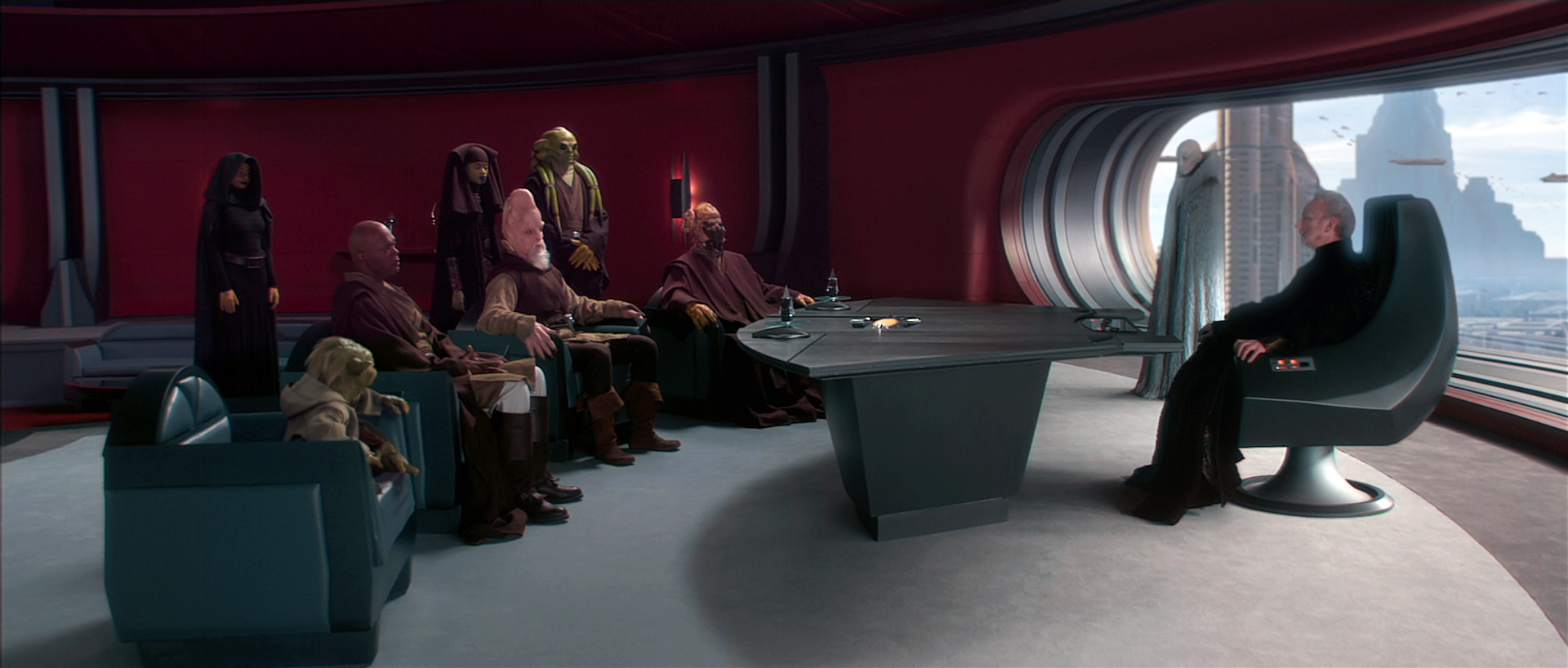
The Jedi Council and the Supreme Chancellor, leader of the Galactic Senate, work together for the good of the Republic.
To better improve the chances of preserving the fledgling New Republic, the Senate recognized the necessity of ensuring the Order's full reconstitution. Even after the New Republic reorganized itself into the Galactic Alliance, a government that more closely resembled the Old Republic, the Jedi gradually resumed their former role as peacekeepers and emissaries for the Galactic Alliance Senate. By 44 ABY, the relationship between the Jedi and the government was strikingly similar to their former association with the Old Republic's Senate, which culminated with another Jedi coup d'état against the government—one that actually succeeded in the overthrow of a tyrannical head of state and with the approval of the Senate.
The Galactic Republic's influence on the galactic economy was linked to its regulatory powers, production of Republic dataries, and authorization of relevant bodies.
At the heart of the galactic economy was the planetary trade. The Interplanetary trade could support a local economy, but, in many cases, the high levels of economic interaction and the massive scale of exchange required for an advanced society could only be funded by interplanetary exports. While some planets maintained their own shipping fleets, most relied on large freight firms, such as Xizor Transport Systems, or independent freight haulers to carry their goods along major hyperlanes.
The Corporate Sector was first formed in 490 BBY to free the Republic lawmakers and the Corporate moneymakers from their differences. In the last millennia of the Galactic Republic, commercial interests began to form guilds to increase their influence on relevant legislation and achieve greater efficiency. While most of these guilds, like the Trade Federation, Techno Union, and the Commerce Guild, collapsed after the Clone Wars, a number of surviving members flocked to the Corporate Sector Authority.
Thousands of currencies were used across the galaxy. The Galactic Republic's dataries were perhaps the most widespread form of currency. Because of the Republic's exceptional membership, dataries were accepted on all but the most remote planets. From its inception, the credit was backed by the immense wealth of the planet Muunilinst and the InterGalactic Banking Clan. During the Clone Wars, the IGBC backed the currencies of both sides.
Working beings were required to pay taxes, which were collected by the Republic Tax Collection Agency. In the later years of the Galactic Republic, a transit tax of 15% was levied to raise revenue for the government.
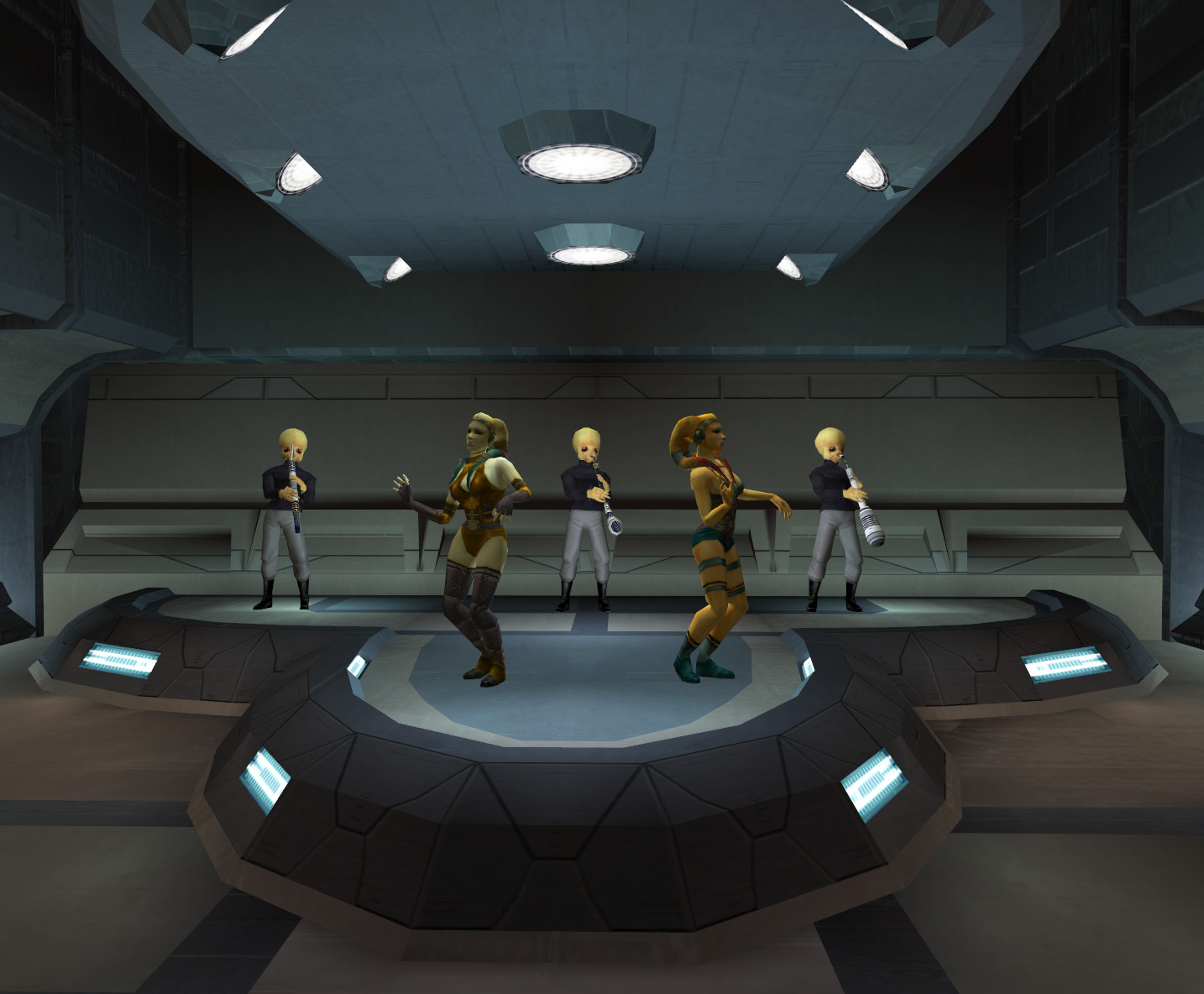
The stage of a cantina on Taris.
The Galactic Republic had a very diverse culture. Member worlds were able to maintain their own culture in accordance with local beliefs, customs, and traditions. There was a wide variety of different cultures within the Republic: from religious communities like the Jedi to hive-like communes.
The Republic had a liberal policy towards arts also. The dominant aesthetic style of Galactic Republic-era was opulence and ornamentation.
Although Humanocentrism was technically outlawed by the Rights of Sentience clause of the Galactic Constitution, it still very much existed throughout the life of the Galactic Republic. Human-led organizations such as Czerka enslaved entire nonhuman races, while planetary governments such as that of Taris reserved the best sections of the world for Humans while forcing non-humans into ghettos. The majority of slaves in the galaxy were non-humans. At the time the Clone Wars broke out, there were still lawsuits pending about pro-Human bias in the Republic government.
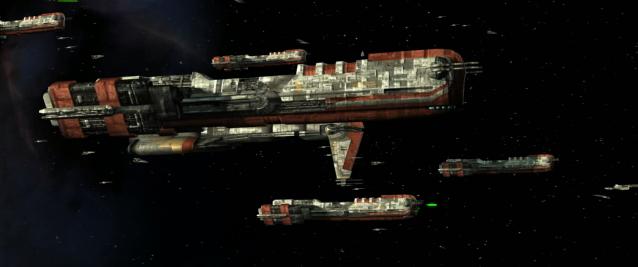
A Republic fleet during the Jedi Civil War.
The Republic's earliest days were not peaceful ones, since, as the Republic expanded across the galaxy, it encountered many warlike species. The Republic realized the need for an army and navy to keep the peace. The Republic's military forces would serve throughout many conflicts, including the Great Hyperspace War, the various conflicts of the Old Sith Wars, and the New Sith Wars as well as the absolutely ravenous Great Galactic War.
After the Ruusan campaign, the Republic decommissioned much of its military, retaining a small force only for security purposes. This force would later become known as the Judicial Department. This was to display the Republic's peaceful ideals, as the Republic used Jedi Knights as "keepers of the peace."
Several trade corporations, such as the Trade Federation, the InterGalactic Banking Clan, and the Commerce Guild, kept their own security forces in order to protect their profits, but they often abused this power, such as in the Battle of Naboo. Individual sectors also maintained their own security forces, such as Naboo's Royal Naboo Security Forces or CorSec from Corellia, and these were sometimes used to combat small threats. However there was no centralized command, and the members of the late-period Republic loathed change.
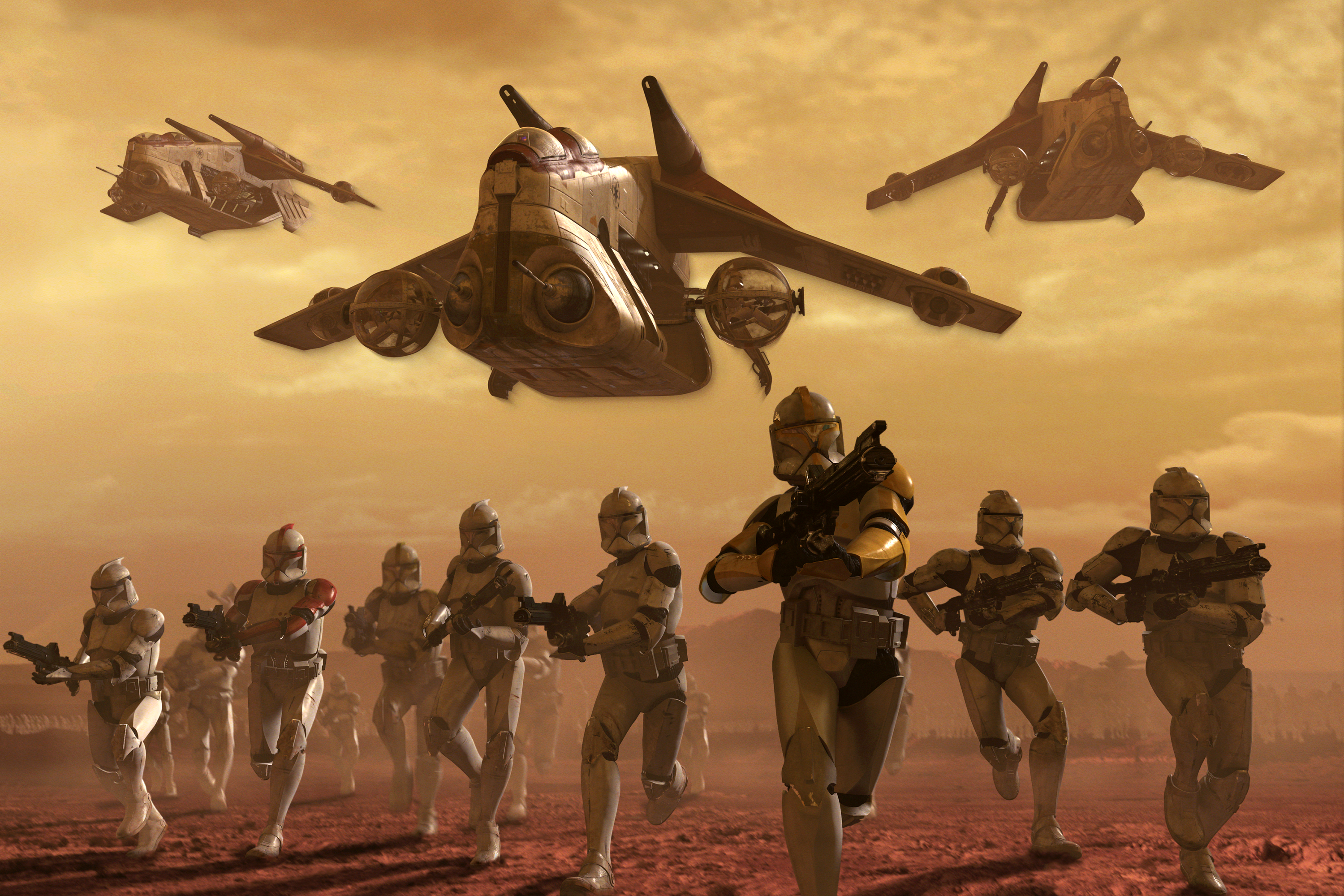
The Grand Army of the Republic leading the charge on Geonosis.
The Clone Wars changed all this. The Republic had no standing military to combat the Confederacy of Independent Systems, and thus a Military Creation Act was proposed, which was strongly opposed by many of the Republic's pacifist leaders such as Padmé Amidala of Naboo, who feared the possibility of going to war. Supporters of the Military Creation Act included Orn Free Taa of Ryloth and Ask Aak of Malastare.
However, a clone army had already been created in secret on the remote planet Kamino, ten years earlier. When it became clear the Confederacy had no intention of negotiating with the Republic, the Republic adopted this army, along with AT-TE walkers, LAAT/i and LAAT/c gunships, A5 and A6 Juggernauts, Acclamator-class assault ships, Victory I-class Star Destroyers, and Venator-class Star Destroyers, BARC speeders, among numerous other craft and vehicles, in a combined force known as the Grand Army of the Republic. The army was unleashed in 22 BBY on Geonosis against the Separatist droid forces. These loyal troops would serve in many battles throughout the conflict and on worlds such as Muunilinst, Dac, Jabiim, Praesitlyn, Cato Neimoidia, and even Coruscant. Ever since the unveiling of the Republic's secret clone army, the clones found themselves to be at the center of a great deal of controversy throughout the Clone Wars. While virtually all of the clones professed their unwavering loyalty to the Republic and their desire to fight and die for it, ultimately clones were either pitied by some sympathizing individuals or despised and not trusted by others. While Jedi such as Etain Tur-Mukan sympathized with the clones and developed an affinity for them, others like Rahm Kota immensely distrusted the clones and felt that non-clone combatants made better soldiers on the battlefield. Regardless of the perceived "slave army" status and all attempts to treat the clones humanely, sympathy and an increasing reliance on the clones was a grievous error on the Republic's part as Order 66 and the rise of the Empire would prove. Under the Galactic Republic, there were those who cared for the clones and how they felt. Under the Galactic Empire, they would never be perceived as anything more than what they always were: a product and a disposable army of droid-like human soldiers.
In 19 BBY, Supreme Chancellor Palpatine transformed the Galactic Republic into the Galactic Empire. The loyal clone troopers of the Grand Army of the Republic would become the dreaded stormtroopers of the Stormtrooper Corps, while the regulars and starships were segmented into the Imperial Army and Imperial Navy, respectively. However, due to the fact that the clones aged at twice the rate of ordinary humans, regular human recruits would finally be implemented into the stormtrooper ranks - much to the quiet dismay of Jango Fett's clones. While the Stormtrooper Corps remained evenly divided between clones and birth-born soldiers, cloning had been virtually phased out as the remnants of the fallen Empire were forced to rely completely on ordinary humans and non-humans alike - thus phasing out the last remnants of the Galactic Republic's clone army.
The Galactic Republic was composed of a significant portion of the known galaxy, stretching from the Core Worlds to at least partially, the Outer Rim Territories, though it was widely believed that the government held little power in the outlying regions, and preferred to focus its attention on the Core Worlds and Colonies. The exact number of planets in the Republic fluctuated, ranging from three million worlds to just over a thousand, but in 21 BBY it was a little less than 1.3 million planets, with some 10-40,000 systems controlled by the Separatists. The Senate was in control of thousands of star systems while more than two hundred systems had defected to join the Confederacy of Independent Systems by the time Palpatine finally ended the Republic.
The capital of the Galactic Republic was Coruscant, a planet considered to be the cultural and economic center of the galaxy, despite being located outside of the Deep Core. To signify its importance in galactic affairs, Coruscant was given coordinates 0-0-0 in the standard galactic coordinate system.
In the Expanded Universe, the Republic is well established to be extant for 25,000 years, based on Obi-Wan Kenobi's line in A New Hope that the Jedi had been "the guardians of peace and justice in the Old Republic" "for over a thousand generations." For a long time, EU sources were the only works set during the Republic era—most notably, the popular Tales of the Jedi sagas. However, in Star Wars: Episode II Attack of the Clones, Palpatine mentioned the Republic had "stood for a thousand years." This would seem to conflict with both the C-canon EU history and the G-canon internal continuity within the films. In G-canon, the second season of the Clone Wars Tv show made a reference to a fallen "Old Republic", in which the Jedi Order was also present, predating the Republic of the Prequel-era. Prior that, in the Expanded Universe, the Ruusan Reformation—in which the Republic is reorganized following the already-established defeat of the Sith a thousand years prior to the films—was invented by subsequent writers to give an alternate explanation on Palpatine's line, thus bringing all these sources into relative harmony. Palpatine could also be considering the Republic Dark Ages as a temporary disbandment, the Republic essentially reforming after the Ruusan Reformation in 1000 BBY.
During Cannes Film Festival in 2005, franchise creator George Lucas when presenting the film and explaining the themes of democracy being allowed by the people to become a dictatorship implied that the overall state of the Galactic Republic in the prequel trilogy, especially the leadup to the Galactic Empire in particular, was based on that of the Roman Republic under Julius Caesar, the revolutionary France under Napoleon Bonaparte, and the Weimar Republic of Germany under Adolf Hitler.
- Jedi Academy: The Phantom Bully
- LEGO Star Wars: The Video Game
- LEGO Star Wars: The Complete Saga
- LEGO Star Wars: The Quest for R2-D2 game
- LEGO Star Wars: The Quest for R2-D2 film
- LEGO Star Wars: The Yoda Chronicles video game
- LEGO Star Wars: Microfighters video game
- LEGO Star Wars: Revenge of the Brick
- LEGO Star Wars II: The Original Trilogy
- Star Wars Battlefront: Renegade Squadron
- LEGO Star Wars: The Padawan Menace
- LEGO Star Wars: The Dark Side